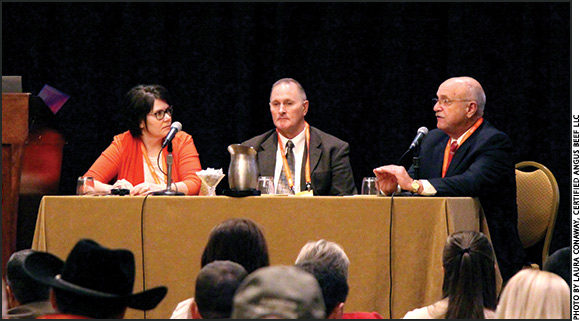
Panelists (from left) Deb VanOverbeke, Oklahoma State University; Keith Belk, Colorado State University; and Jeff Savell, Texas A&M University, shared history, current status and what’s in store for the National Beef Quality Audit.
25 Years of NBQA
Audit information shows patterns of consistency, areas to improve.
 “Without data, you’re just another person with an opinion.”
“Without data, you’re just another person with an opinion.”
A pioneer in the world of business process reengineering, W. Edwards Deming conceptualized the notion. The National Beef Quality Audits (NBQA) and the National Market Cow and Bull Beef Quality Audit (NMCBBQA) applied it.
Attendees of the 2017 Cattle Industry Convention & NCBA Trade Show in Nashville, Tenn., Feb. 1-3 had the chance to take in an overview. That data and implications for what’s to come from new research were presented during the Cattlemen’s College session “25 Years of National Beef Quality Audit Impact.”
“If we could implement Dr. Deming’s philosophies and recapture all or part of the opportunity lost, we could make the beef production system more profitable,” said Keith Belk, professor of meat safety and quality at Colorado State University, of the motivation that kick-started the program in 1991.
Research conducted in 1990 revealed the beef industry was losing nearly $12 billion per year due to defects. At the time, demand was steady, yet beef market share had declined. At a loss of $458 per head, there were inefficiencies to be regained.
The goal was simple: Cease dependence on inspection to achieve quality. Instead of a reactive approach that found and attempted to eliminate effects after they were produced, the audit brought to light how beef producers could avoid such defects in the first place.
Committed to the formula that “demand equals price over satisfaction,” Belk said, “The idea was you would implement these process controls and you would improve the quality and efficiency of the production system.”
That goal exists today, along with 25 years of data that support it.
“It’s been a great learning opportunity for us to understand what we’re producing in the United States,” said Jeff Savell, distinguished professor of meat science at Texas A&M University.
Savell, who has worked on the audit since its 1991 inception, walked the audience through the three phases of data collection:
Phase 1: Face-to-face interviews that target open-ended discussion.
Phase 2: In-plant assessments looking for live physical indicators such as lameness, cancer eye and other live defects, as well as carcass characteristics like bruising and injection-site lesions.
Phase 3: Workshops to assess Phase 1 and 2 findings and to develop strategies for improvement.
In tandem with USDA inspectors, researchers set out to determine why particular cattle were condemned. Historically they focused on liver, lung, head and tongue. More recently, “lung condemnation has been important for us to think about, given some of the issues with feedlot cattle and their health,” Savell said.
The 2011 addition of instrument and camera grading enabled the analysis of nearly 4.5 million carcasses.
Savell said today’s NBQA project has data from every week of the year and will start looking at month-to-month variation, then eventually day-to-day.
Deb VanOverbeke, Oklahoma State University meat scientist, spoke on details of the NMCBBQA audits conducted in 1994, 1999 and 2007 with similar strategies to the feeder-cattle model.
Quoting Tom Field in a 1999 workshop, VanOverbeke said, “Success is not doing one thing 100% better; it’s doing 100 things 1% better. You really can make a huge impact on the marketability of cattle.”
Improving quality, decreasing fat thickness, controlling weights — those are some of the successes tied to the NBQA, including the emphasis placed on eliminating injection-site blemishes.
Results from the 2016 NBQA and NMCBBQA will be available at NCBA’s summer conference and the 2018 Cattle Industry Convention, respectively.

Editor’s Note: Laura Conaway is producer communications specialist for Certified Angus Beef LLC. This article was written as part of Angus Media’s coverage of the 2017 Cattle Industry Convention. For further coverage, visit www.angus.media.






